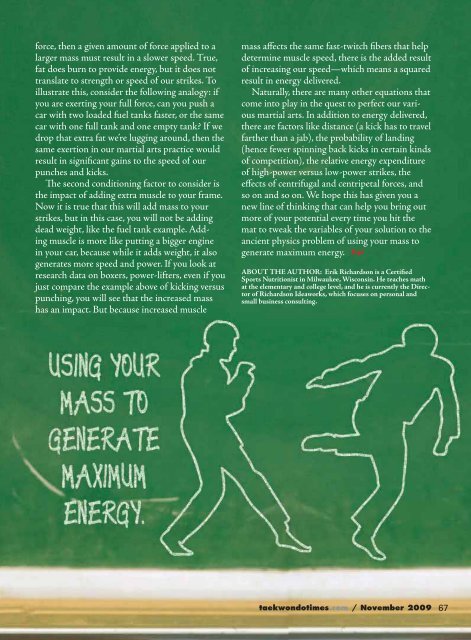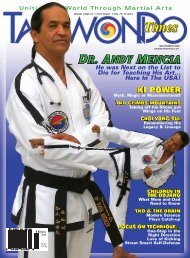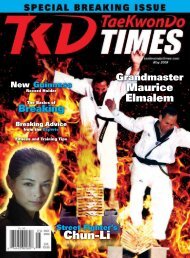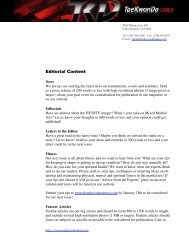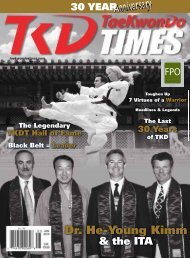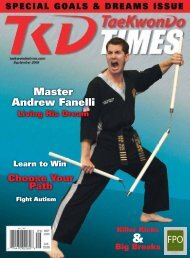Grandmaster Ken MacKenzie - Taekwondo Times
Grandmaster Ken MacKenzie - Taekwondo Times
Grandmaster Ken MacKenzie - Taekwondo Times
Create successful ePaper yourself
Turn your PDF publications into a flip-book with our unique Google optimized e-Paper software.
force, then a given amount of force applied to a<br />
larger mass must result in a slower speed. True,<br />
fat does burn to provide energy, but it does not<br />
translate to strength or speed of our strikes. To<br />
illustrate this, consider the following analogy: if<br />
you are exerting your full force, can you push a<br />
car with two loaded fuel tanks faster, or the same<br />
car with one full tank and one empty tank? If we<br />
drop that extra fat we’re lugging around, then the<br />
same exertion in our martial arts practice would<br />
result in significant gains to the speed of our<br />
punches and kicks.<br />
The second conditioning factor to consider is<br />
the impact of adding extra muscle to your frame.<br />
Now it is true that this will add mass to your<br />
strikes, but in this case, you will not be adding<br />
dead weight, like the fuel tank example. Adding<br />
muscle is more like putting a bigger engine<br />
in your car, because while it adds weight, it also<br />
generates more speed and power. If you look at<br />
research data on boxers, power-lifters, even if you<br />
just compare the example above of kicking versus<br />
punching, you will see that the increased mass<br />
has an impact. But because increased muscle<br />
mass affects the same fast-twitch fibers that help<br />
determine muscle speed, there is the added result<br />
of increasing our speed—which means a squared<br />
result in energy delivered.<br />
Naturally, there are many other equations that<br />
come into play in the quest to perfect our various<br />
martial arts. In addition to energy delivered,<br />
there are factors like distance (a kick has to travel<br />
farther than a jab), the probability of landing<br />
(hence fewer spinning back kicks in certain kinds<br />
of competition), the relative energy expenditure<br />
of high-power versus low-power strikes, the<br />
effects of centrifugal and centripetal forces, and<br />
so on and so on. We hope this has given you a<br />
new line of thinking that can help you bring out<br />
more of your potential every time you hit the<br />
mat to tweak the variables of your solution to the<br />
ancient physics problem of using your mass to<br />
generate maximum energy.<br />
ABOUT THE AUTHOR: Erik Richardson is a Certified<br />
Sports Nutritionist in Milwaukee, Wisconsin. He teaches math<br />
at the elementary and college level, and he is currently the Director<br />
of Richardson Ideaworks, which focuses on personal and<br />
small business consulting.<br />
taekwondotimes.com / November 2009 67


